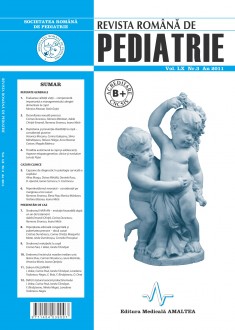SELECT ISSUE

Indexed

| |

|
|
|
| |
|
|
|

|
|
|
|
|
|
|
HIGHLIGHTS
National Awards “Science and Research”
NEW! RJP has announced the annually National Award for "Science and Research" for the best scientific articles published throughout the year in the official journal.
Read the Recommendations for the Conduct, Reporting, Editing, and Publication of Scholarly work in Medical Journals.
The published medical research literature is a global public good. Medical journal editors have a social responsibility to promote global health by publishing, whenever possible, research that furthers health worldwide.
Neonatal hyperthyroidism – discussions on three clinical cases
Ramona Stroescu, Elena Pop, Monica Marazan, Teofana Bizerea and Ioana Micle
ABSTRACT
Introduction: Neonatal hyperthyroidism occurs în infants from mothers with Graves Basedow, with an incidence of 1:70.
Purpose: Highlighting the risks and complications that may appear în infants of mothers with Graves’ disease.
Method: The cases of three newborns resulted from risk pregnancies (mothers known with Graves’ disease) diagnosed with neonatal hyperthyroidism, are addressed. Admission status and evolution of each case were different, depending on the mother’s compliance regarding the treatment and on the mothers (TSI) antibody levels. în the first case, admitted at the age of one day with thyrotoxicosis, the mother interrupted treatment throughout pregnancy. In the two cases which followed treatment during pregnancy, mothers TSI level during pregnancy was different: the patient with high TSI levels originally developed subclinical hypothyroidism due to transplacental passage of oral antithyroid medication, subsequently developing clinical symptoms of hyperthyroidism (agitation, tachycardia, growth retardation). In the third case, the mother’s hard to control, persistent, thyrotoxicosis, throughout the whole pregnancy, affected the intrauterine development (gestational week 33 weeks). He presented with a mild form of hyperthyroidism caused by low amounts TSI antibodies during the pregnancy. The evolution was favorable with the normalization of the thyroid function; at the age of 3 months, no maternal antibodies have been detected in infants.
Discussion: The risk of newborn thyrotoxicosis represents an emergency, antithyroid treatment followed by the mother has an essential role; high doses increase the risk of perinatal hypothyroidism. The severity of the symptoms depends on the antibody (TSI) levels which cross the placenta.
Conclusions: Monitoring the newborn from mothers with Graves’ disease is essential; it should begin from the intrauterine period and continued until at the age of 3-6 months. Reaching euthyroidism în both mother and the newborn is difficult to obtain and requires interdisciplinary collaboration
Key words: newborn, transient neonatal hypo-/hyperthyroidism, Grave’s disease
